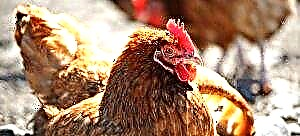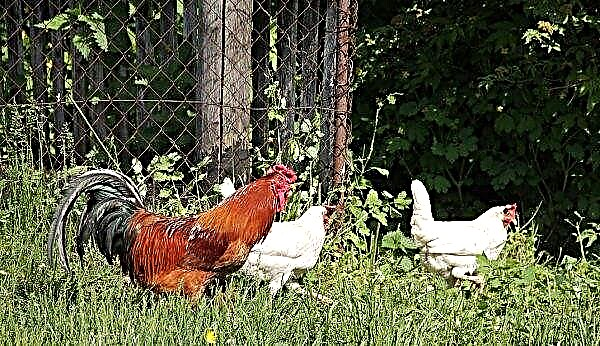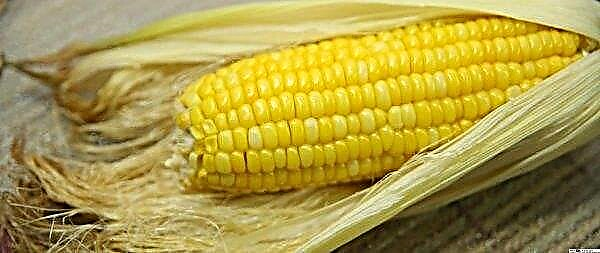Laying hens are kept in special conditions. Failure to comply with these conditions will lead to the spread of various diseases that can be very dangerous. What kind of disease, and how to treat each ailment at home - this review will tell about all this.
List of major diseases
Most often, poultry suffer from bacterial, viral and parasitic diseases. They can affect various organs and parts of the body.
Did you know? Chickens use 24 different sounds to communicate with each other.
Chicken eye disease
In nature, there are five major eye diseases in chicken. Each of them is quite dangerous, so you can not delay treatment:
- Neoplasms of the eyelids. The main symptom is growths and swelling on the eyelids, which can lead to poor vision of the bird. The treatment consists in enriching the diet with vitamins A and D.
- Conjunctivitis. Symptoms: redness, discharge of pus or mucus. For treatment, drops are used, and in especially advanced cases - antibiotics.
- Abscess of the eyelids. In most cases, the lower eyelid suffers, it begins to sag. Treatment is based on antibiotics prescribed by the veterinarian after determining the cause of infection with this infection.
- Xerophthalmia. The work of the lacrimal canal is disrupted, which leads to the drying of the cornea of the eye. Treatment involves the inclusion of foods with a high content of vitamin A.
- Ammonia blindness. In birds, inflammation of the mucous membrane of the eye and discharge from the nose in the form of mucus are observed. The eyes of the diseased individual should be washed with strong tea without additives or chamomile.
Foot disease
There are a number of diseases that affect chicken paws. Below are some of them.
- Arthritis. Symptoms are inactivity, lethargy, lameness, an increase in paw size, fever. The disease develops due to mechanical damage, as well as non-compliance with care rules.
- Tendon displacement. It may occur due to a lack of manganese and vitamin B. Visually, it is easy to determine the displacement - the joint is inverted to the other side.
- Mycoplasmal synovitis. He is susceptible to birds with weak immunity, often having another infection. Manifestations: redness of the legs, hock joint hardening.
- Tendovaginitis, or inflammation of the tendons. It develops mainly in birds aged after mechanical damage. Of the symptoms, convulsions, redness of the joint zone, pain, weakness of the affected organ are distinguished.
 Prevention, like treatment, consists in a proper diet with a regulated content of vitamin A and D and compliance with all care rules.
Prevention, like treatment, consists in a proper diet with a regulated content of vitamin A and D and compliance with all care rules.Why chickens fall on their feet
There are times when a chicken begins to fall to its feet. The reasons may be different. This can be due to diseases (mainly arthritis or tendon inflammation). This happens due to mechanical damage, lack of necessary vitamins and improperly selected conditions of detention.
Did you know? Chicken is able to recognize and distinguish more than 100 human faces.
Infectious diseases
Infectious and viral diseases are the leading cause of chicken death. Most often, salmonellosis, mycoplasmosis, chicken typhoid, pasteurellosis, colibacteriosis, mycotoxicosis, tuberculosis are found on the farm.
- Salmonellosis The main symptoms are acute diarrhea and a decrease in the number of laid eggs, and in the advanced stage, inflammation of the ovaries and fallopian tubes of the individual is added.

- Mycoplasmosis Bacteria of this infection affect the organs of the respiratory system, as a result of which there are mucous discharge from the nose and eyes, edema of the orbit. The birds get nervous, they begin to shake their heads. It is very difficult to cure an infected individual, therefore it is better to resort to preventive measures, preventing infection.

- Typhoid Chicken Typical manifestations of typhoid fever are a significant decrease in the amount of feed consumed, lethargy, feather loss, blue comb, and a decrease in egg production. Chemotherapy drugs are used for treatment.
- Pasteurellosis. Symptoms: fever, discharge of their nose, shortness of breath and diarrhea. Often the infection does not manifest itself, and the chickens suddenly die.
- Colibacillosis. The infection affects the respiratory tract, shortness of breath, sneezing and runny nose appear, the nasal mucosa becomes inflamed.
- Mycotoxicosis. It affects the nervous, circulatory and digestive systems.
- Tuberculosis. The disease is characterized, first of all, by a deterioration in the general condition of the bird and a decrease in their activity. Lameness and diarrhea appear. Tuberculosis is not treated; the vaccination method is used for prevention.
Viral diseases
Viral diseases are characterized by causing high mortality among livestock. Most often enter the body of an animal through water, litter and food. Among the most serious diseases are:
- Newcastle disease. First of all, it affects the nervous system - there is paralysis of the legs and wings, muscle tremors, malfunctions of the digestive tract, apathy, drowsiness, and swelling of the head. The main way to fight is early vaccination.
- Laryngotracheitis. It leads to a decrease in the number of eggs to 60%, inflammation of the trachea and mucous membrane of the larynx. Often infected individuals have edema of the orbits, conjunctivitis.
Find out also

- Syndrome of egg production. The main symptom is a decrease in the number of eggs laid by chickens. The egg shell is thin and deformed, often with altered pigmentation. In especially severe cases, the chicken can lay eggs without any shell at all.
- Smallpox. Yellow spots appear on the skin of the bird, which eventually acquire a reddish hue, and then turn into nodules. Of these, exudate of gray color begins to stand out, which forms a crust. The disease goes away after 7-10 days.
- Marek's disease. Manifestations: disturbances in the digestive tract, weakness, lack of appetite, weight loss, after which paralysis may develop.
Why do chickens die
There are many reasons for the increased mortality of chickens, but the main thing remains improper maintenance and care, and non-compliance with hygiene standards. This leads to the spread of infections and viruses, which subsequently causes dangerous diseases. Most often, birds die due to:
Most often, birds die due to:
- dropsy of the abdomen,
- bronchopneumonia,
- flu
- ascariasis,
- Newcastle disease.
Important! Treatment of viral diseases rarely gives the desired result, therefore, in order to avoid infection, it is necessary to vaccinate on time.
Why do chickens sneeze
There are times when chickens cough, wheeze, and also often sneeze. Basically, this symptom appears with respiratory diseases. Diseases that cause sneezing:
Diseases that cause sneezing:
- infectious bronchitis,
- bronchopneumonia,
- mycoplasmosis
- colibacillosis.
Important! If symptoms of an infectious or viral disease are detected in a bird, immediately isolate it from other individuals.
Chicken is susceptible to various infections, which in most cases are not treatable. Experienced farmers prefer to prevent the disease through vaccination.















